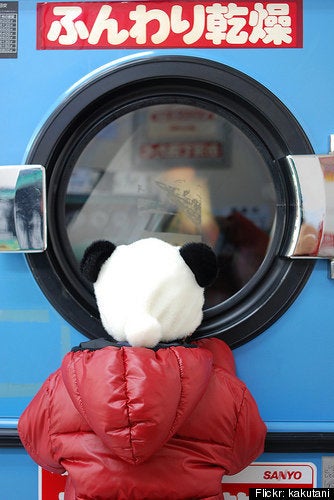
Guest post by Chelsea Green's Makenna Goodman:
Behold the classic domestic duos of the past: Ricki and Lucy. Ozzie and Harriet. Bennifer. Tom and Jerry. Bush and Cheney. And most important of all, not to mention the most seriously detrimental to human society—um, make that second most serious—the washer and the dryer. Readers may doubt the importance of separating the latter, but a divorce must be arranged. The dryer, as it were, is an energy-sucking, money-vaporizing, obsolete object that has served its last purpose. Feel free to recycle it, make better use of it, or fill it with water and use as a pleasant place for baby ducks to frolic in your yard. But seriously, if you want to save money this summer, you may have to part with your Maytag and those handy Bounce sheets, and embrace other ways to dry your clothes.
According to Stephen and Rebekah Hren, authors of The Carbon-Free Home: 36 Remodeling Projects to Help Kick the Fossil-Fuel Habit, throwing out your dryer is a wicked way to save money this summer.
Electric clothes dryers are a colossal waste of energy. They often draw around 6,000 watts. Six thousand! This is more than a typical heat pump or electric water heater, usually thought of as the hogs of the household. Simply put, you should not use this appliance. Gas dryers are more efficient because they use no electric-resistant heat, but they can still draw around 720 watts. That's a lot, equivalent to about 60 compact fluorescents (not to mention the energy of the gas). You should plan on getting rid of electric heat dryers and hopefully gas-fired dryers as well if your climate allows.
Solar clothes drying shows this energy source at its finest. It's a great example of simplicity combined with effectiveness. Hang up something wet in the sun, come back in a few hours, and voilà, it's dry, clean, and fresh smelling. Like everything, having the proper tools to access this resource goes a very long way in making sure it's effective and easy to do. Some of this depends on your climate and your own personal habits. We realize some parts of the country have very little sun in the winter, but if you set aside a bit of room, even in a closet or a spare bedroom, clothes hung on racks will dry fairly quickly in a heated house.
Just for the record, I am not an eco-psycho. I am a recent convert to the drying rack, and I choose to keep it covered in wet clothes, by a breezy window facing the sun. Actually, to be honest, I was sort of forced to shun the electric dryer—my boyfriend won't let me turn the damn thing on. He's a better man than I, with weightier morals. So yesterday while he was out of town, I cheated. I gathered together a bundle of cut-offs, sweatpants, and dirty socks and thought, Oh yes. Now's my time. I'm gonna get my clothes real warm and dry. But as I began to open our dryer (which I'm about to get rid of), I caught sight of the indoor drying rack, waiting in the sun. I remembered the last batch of laundry, and how it smelled like clean grass. I thought of my electric bill. About my rapidly depleting checking account. The choice, in the end, is actually pretty obvious, and after a couple times using solar drying techniques (clotheslines included), my lazy reflex wore off. I now see it as meditating and investing in my solvent future. Out it goes!
- Retractable clothesline: An excellent tool for the space-constrained. These come in a variety of lengths and are very simple to install indoors or out. Consider putting these inside near a passive solar wall. The sun will dry the clothes and raise the humidity of the room in wintertime, making it more comfortable inside.
- Indoor drying rack: Avoid the cheaper models, as they can fall apart rather quickly. These are generally collapsible and can stand alone or be wall-mounted. I recommend having at least two. Being able to place these in sun or near a woodstove will greatly speed up drying time in the winter.
- Outdoor drying rack: If you've got the room outdoors, a permanent outdoor rack is a very effective method for drying clothes, even when the temperatures barely get above freezing. It requires some time to mount properly, but it should function well for decades.
- Clothespins: These are a necessity and come in two varieties: split or spring. Determine your preference and make sure you have plenty. Hanging clothes from pins rather than folding them over the line greatly speeds drying time and greatly reduces the odds that any clothing will fall off and get dirty. Folding clothes generally means two sides of the clothing are not exposed to the air at all. This more than doubles drying times.
Makenna Goodman works and blogs for Chelsea Green Publishing, a leading community providing books and dialogue on the politics and practice of sustainable living.